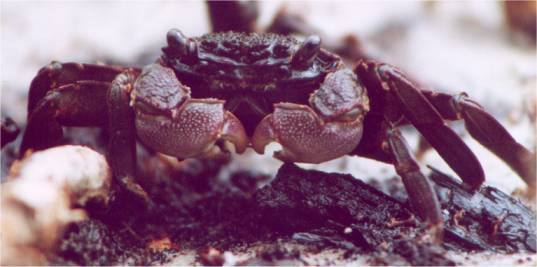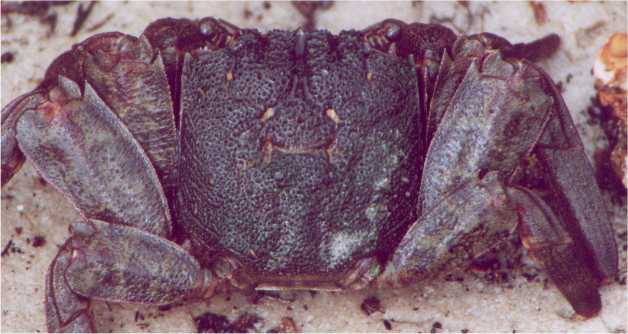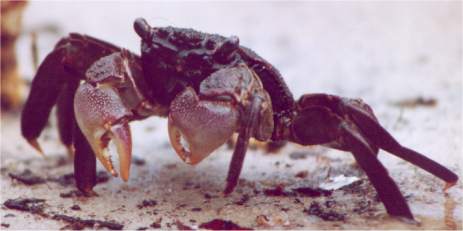|
A field guide to Kenyan
mangroves
|
Selatium elongatum (H. Milne Edwards, 1869)
Family: Sesarmidae

Zone: Extreme seaward side of mangal, prefers R. mucronata (Vannini et al., 1997; Cannicci et al., 1999).
Habitat: A narrow zone, above water, on the trunk of seaward mangrove trees; strictly mangrove dependent (Cannicci et al., 1999).
Food: Algae and leaves, but is an opportunistic omnivore and includes insects and mollusks in its diet (Cannicci et al., 1999; Dahdouh-Guebas et al., 1999).
Ecological notes: Remains out of water; most active at high tide; remains on trees (Vannini et al., 1997; Cannicci et al., 1999).
| Distinguishing characteristics: Mersus of
walking legs broad, with the length twice the width or slightly less. Carapace
brownish violet; external claw lighter; legs mottled. (Carapace width about
3 cm).
Geographical range: Somalia, Tanzania, Madagascar, Andamane, Indonesia (Vannini and Valmori, 1981), Kenya. |
 |

References:
Cannicci, S., F. Dahdouh-Guebas and L. Montemagno, 1993. "Field Keys for Kenyan Mangrove Crabs." Museo Zoologico "La Specola", Dipartimento di Biologia Animale e Genetica dell'Università Degli Studi di Firenze, Via Romana 17, I-50125 Firenze, Italia.
Cannicci, S., S. Fratini and M. Vannini, 1999. Use of time, space and food resources in the mangrove climbing crab Selatium elongatum (Grapsidae : Sesarminae). Marine Biology 135 : 335-339.
Hartnoll, R.G., 1975. "The Grapsidae and Ocypodidae (Decapoda: Brachyura) of Tanzania." J. Zool. Lond. 177:305-328.
Vannini, M. and P. Valmori, 1981. Researchers on the coast of Somalia. The shore and the dune of Sar Uanle. 30. Grapsidae (Decapoda Brachyura). Monitore Zoologico Italiano 6: 57-101.
Vannini, M., A. Oluoch and R.K. Ruwa, 1997. "Tree-climbing decapods of Kenyan mangroves." In Kjerfve, Björn, Luiz Drude de Lacerdaand El Hadji Salif Diop (eds.). Mangrove ecosystem studies in Latin America and Africa. UNESCO Technical Papers in Marine Science, Paris, France: 325-338.